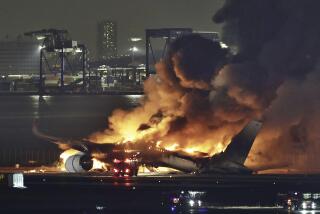Device Could End Jet Fuel Tank Peril
- Share via
WASHINGTON — An aviation safety breakthrough by government scientists has led to affordable technology that could virtually eliminate catastrophic fuel tank explosions like the one that destroyed TWA Flight 800, Federal Aviation Administration officials said Tuesday.
FAA Administrator Marion C. Blakey said the agency planned to require the airline industry to install new equipment on about 3,800 Boeing and Airbus passenger jets -- the bulk of the commercial fleet. The process of issuing a regulation and phasing in the fixes could take nearly 10 years, at a cost of $140,000 to $220,000 per plane.
The “industry simply cannot afford to not have this safety net in place,” Blakey said. “It would be irresponsible not to move forward with a technology like this.”
The new device, which can be installed in the cargo hold, would pump nonflammable nitrogen from the air into the fuel tanks, making fumes much less likely to ignite. FAA scientist Ivor Thomas developed a prototype.
TWA Flight 800, a Boeing 747 bound from New York to Paris, blew up off Long Island in July 1996, killing all 230 aboard. At first, many suspected a terrorist attack, but the disaster was ultimately blamed on a short circuit that ignited fumes in a nearly empty fuel tank. The explosion tore the plane apart 13,800 feet above the Atlantic Ocean.
Boeing will not wait for a federal mandate, a spokeswoman said, but will begin installing its version of Thomas’ device on newly built 747s in the latter part of 2005. Boeing 747s that are already in service, as well as airplanes of other models built by the firm, would follow.
An Airbus spokesman said the company was evaluating the technology, but did not believe its planes had a problem. The super-jumbo Airbus A380, the company’s newest jet, could accommodate the technology.
The FAA focused on Boeing and Airbus because their planes have fuel tanks near sources of heat, such as air conditioning equipment. Planes built by other manufacturers do not.
Family members of Flight 800 victims said fixing the problems with fuel tanks had already taken too long.
“This happened in 1996, and it’s 2004 now,” said Frank Carven, county attorney for Harford County, Md., who lost his sister and nephew in the explosion. “You do the math. It could be 17 years after the fact before this is completed. It’s a good thing, but it’s a disappointment that it’s still so many years down the road.”
The FAA’s Blakey said the agency had taken other measures to increase fuel tank safety. Possible sources of ignition have been eliminated and certain servicing procedures have been changed to reduce the likelihood of overheating a fuel tank. But the problem remains. The odds of a fuel tank explosion have been calculated as high as one every five years, she said.
The last major accident blamed on a fuel tank occurred in March 2001, when a Thai Airways Boeing 737 blew up at the Bangkok airport while that country’s prime minister and 148 other passengers were waiting to board. A flight attendant was killed.
The safety innovation by FAA scientist Thomas had less to do with new technology than with gaining a greater understanding of how an explosion could be prevented, officials said. Thomas demonstrated that it would take less nitrogen than was previously believed to prevent a fuel tank from exploding.
That turned out to be a pivotal finding, because it meant the problem could be solved at a much lower cost.
Before Thomas’ discovery, it was thought that nitrogen would have to be pumped into the fuel tanks during ground service. That would have required installing gas tanks in airport tarmacs, and service equipment to get it into airplanes -- measures the industry viewed as too expensive.
Thomas designed a prototype system that weighs 100 to 200 pounds and can be installed aboard an airliner. The device takes air from the engines, removes oxygen from it, and then pumps the nitrogen-rich mixture into the fuel tanks.
The new insight “was an ‘Aha!’ moment,” said Boeing spokeswoman Elizabeth Verdier. “Once they showed that to us, we said, ‘This is doable.’ ”
The total cost of installing the new equipment on planes already in service could exceed $600 million, and would be the responsibility of the airlines. Nonetheless, it represents a price cut from original estimates, which had ranged into billions of dollars. The FAA expects to issue an initial regulation this year.
A former federal investigator involved in the Flight 800 probe said the industry had used cost to dismiss previous proposed safety fixes, without thoroughly studying all the possibilities.
“This safety feature was studied at the time of the development of most modern jet aircraft, and got left on the design floor because of cost,” said Jim Hall, former chairman of the National Transportation Safety Board. “It took one individual at the FAA to bring some reality to the issue. This highlights the difficulties for government regulators when inflated estimates are given on safety fixes, and eventually they turn out to cost a lot less.”
(BEGIN TEXT OF INFOBOX)
Improving safety
The Federal Aviation Administration is proposing that about 3,800 Boeing and Airbus aircraft be retrofitted with new fuel tank systems that would prevent ignition of flammable vapors. A breakdown of the planes that would be affected:
Airbus
Model Number of planes A320 729 A300- 198 600 A310 48 A330 44
Boeing
Model Number of planes 737 1,453 747 170 757 654 767 380 777 138
Source: FAA
More to Read
Inside the business of entertainment
The Wide Shot brings you news, analysis and insights on everything from streaming wars to production — and what it all means for the future.
You may occasionally receive promotional content from the Los Angeles Times.










